《英语国家概况》教学大纲
英语国家概况
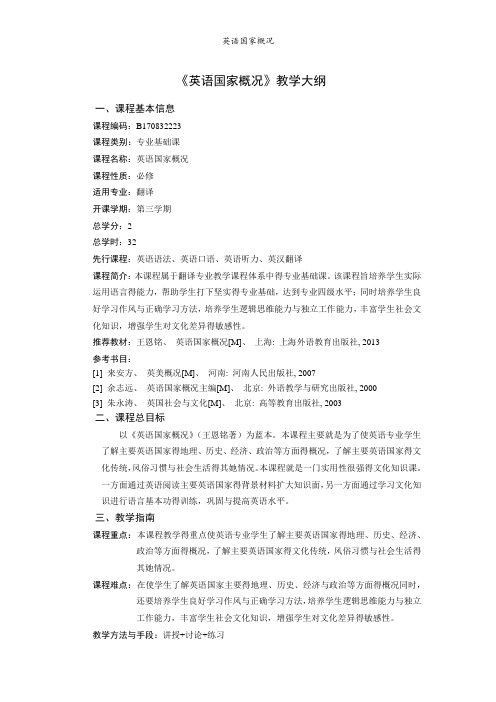
《英语国家概况》教学大纲一、课程基本信息课程编码:B170832223课程类别:专业基础课课程名称:英语国家概况课程性质:必修适用专业:翻译开课学期:第三学期总学分:2总学时:32先行课程:英语语法、英语口语、英语听力、英汉翻译课程简介:本课程属于翻译专业教学课程体系中得专业基础课。
该课程旨培养学生实际运用语言得能力,帮助学生打下坚实得专业基础,达到专业四级水平;同时培养学生良好学习作风与正确学习方法,培养学生逻辑思维能力与独立工作能力,丰富学生社会文化知识,增强学生对文化差异得敏感性。
推荐教材:王恩铭、英语国家概况[M]、上海: 上海外语教育出版社, 2013参考书目:[1] 来安方、英美概况[M]、河南: 河南人民出版社, 2007[2] 余志远、英语国家概况主编[M]、北京: 外语教学与研究出版社, 2000[3] 朱永涛、英国社会与文化[M]、北京: 高等教育出版社, 2003二、课程总目标以《英语国家概况》(王恩铭著)为蓝本。
本课程主要就是为了使英语专业学生了解主要英语国家得地理、历史、经济、政治等方面得概况,了解主要英语国家得文化传统,风俗习惯与社会生活得其她情况。
本课程就是一门实用性很强得文化知识课。
一方面通过英语阅读主要英语国家得背景材料扩大知识面,另一方面通过学习文化知识进行语言基本功得训练,巩固与提高英语水平。
三、教学指南课程重点:本课程教学得重点使英语专业学生了解主要英语国家得地理、历史、经济、政治等方面得概况,了解主要英语国家得文化传统,风俗习惯与社会生活得其她情况。
课程难点:在使学生了解英语国家主要得地理、历史、经济与政治等方面得概况同时,还要培养学生良好学习作风与正确学习方法,培养学生逻辑思维能力与独立工作能力,丰富学生社会文化知识,增强学生对文化差异得敏感性。
教学方法与手段:讲授+讨论+练习四、理论课程教学内容第一章Britain: Land and People教学目得:掌握英国得自然、地理、人口概况。
英美概况教学大纲
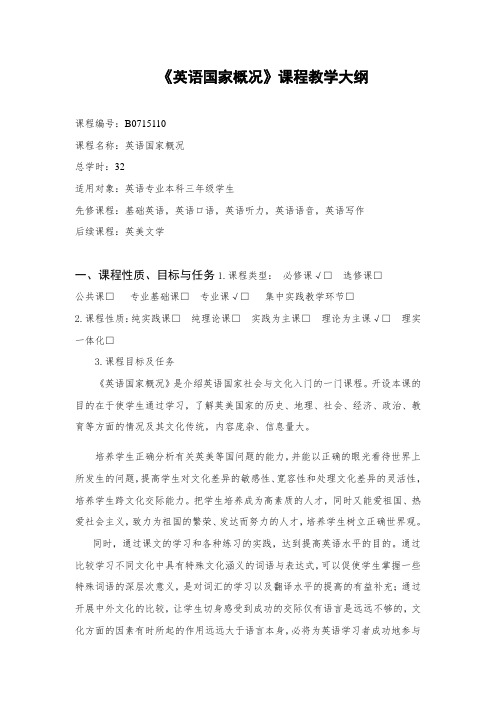
《英语国家概况》课程教学大纲课程编号:B0715110课程名称:英语国家概况总学时:32适用对象:英语专业本科三年级学生先修课程:基础英语,英语口语,英语听力,英语语音,英语写作后续课程:英美文学一、课程性质、目标与任务1.课程类型:必修课√□选修课□公共课□专业基础课□专业课√□集中实践教学环节□2.课程性质:纯实践课□纯理论课□实践为主课□理论为主课√□理实一体化□3.课程目标及任务《英语国家概况》是介绍英语国家社会与文化入门的一门课程。
开设本课的目的在于使学生通过学习,了解英美国家的历史、地理、社会、经济、政治、教育等方面的情况及其文化传统,内容庞杂、信息量大。
培养学生正确分析有关英美等国问题的能力,并能以正确的眼光看待世界上所发生的问题,提高学生对文化差异的敏感性、宽容性和处理文化差异的灵活性,培养学生跨文化交际能力。
把学生培养成为高素质的人才,同时又能爱祖国、热爱社会主义,致力为祖国的繁荣、发达而努力的人才,培养学生树立正确世界观。
同时,通过课文的学习和各种练习的实践,达到提高英语水平的目的。
通过比较学习不同文化中具有特殊文化涵义的词语与表达式,可以促使学生掌握一些特殊词语的深层次意义,是对词汇的学习以及翻译水平的提高的有益补充;通过开展中外文化的比较,让学生切身感受到成功的交际仅有语言是远远不够的,文化方面的因素有时所起的作用远远大于语言本身,必将为英语学习者成功地参与国际商务活动,更有效地进行国际合作与交流打下坚实的文化基础。
二、课时分配三、教学组织Unit OneIntroduction to the UK[教学目标与要求]:Understanding of:1 geographical features, climate2 characteristics of the UK3 history of the UK4distribution of the UK’s population[本章主要内容]:1 geographical features, climate2 characteristics of the UK3 history of the UK4distribution of the UK’s population[本章重点]:1 features of invasion of the UK2 the Great Empire, gentleman[本章难点]:Troubles in the Northern Ireland[本章思考题]:1.What is gentleman?2.The influences of the Great EmpireUnit Two The government of the UK[教学目标与要求]:Understanding of:1 Constitutional Monarchy2 British parliament and its functions3 British government[本章主要内容]:1 Constitutional Monarchy2 British parliament and its functions3 British government[本章重点]:1 Constitutional Monarchy2 British parliament and its functions[本章难点]:Constitutional Monarchy[本章思考题]:1.How long do you think the royal family can exist?Unit ThreePolitics, class and race[教学目标与要求]:Understanding of:1 understanding of the general election of the UK2 social class[本章主要内容]:1 understanding of the general election of the UK2 social class3 races[本章重点]:1 the general election of the UK2 multiracial society[本章难点]:the general election of the UK[本章思考题]:1.The system of general elections and its influence in the worldUnitFour The UK economy[教学目标与要求]:Understanding of:1 understanding the position of the UK after the WW II2. the reason of the decline3 characteristics of British agriculture and industry[本章主要内容]:1 understanding the position of the UK after the WW II2. the reason of the decline3 characteristics of British agriculture and industry[本章重点]:1 the reasons for the decline2.the trends for the British economy[本章难点]:the reasons for the decline he general election of the UK[本章思考题]:1.The privatization and reform in the economic developmentUnitFive British literature[教学目标与要求]:Understanding of:1 the history of British literature3 schools4 divisions of literal periods[本章主要内容]:1 the history of British literature2 writers3 schools4 divisions of literal periods[本章重点]:1 the history of British literature2 well-known writers[本章难点]:divisions of literal periods[本章思考题]:1.Describe a writer/ a school/work you are most familiar with?Unit Six British education system[教学目标与要求]:Understanding of:1 the history of education2 education systems3 higher education[本章主要内容]:1 the history of education2 education systems3 higher education[本章重点]:1 the history of education2 education systems[本章难点]:higher education[本章思考题]:1.Compare British and Chinese higher educationUnit Seven British Foreign RelationsUnderstanding of:1 UK foreign policies and their makings2 Britain and international institutions3 Britain and the United States[本章主要内容]:1 UK foreign policies and their makings2 Britain and international institutions3 Britain and the United States[本章重点]:1 UK foreign policies and their makings2 Britain and the United States[本章难点]:Britain and the United States[本章思考题]:1.The change of British image in international world from Iraqi warUnit Eight the British Media[教学目标与要求]:Understanding of:1 British newspapers2 broadcast media3 television media[本章主要内容]:1 British newspapers2 broadcast media3 television media[本章重点]:1 British newspapers2 broadcast media[本章难点]:British newspapers[本章思考题]:1.The functions of media in cultural acquisitionUnitNine American beginningsUnderstanding of:1 a new land2 the settlement in Virginia3 Puritan New England4 Catholic Maryland5 Quaker Pennsylvania6 American revolution[本章主要内容]:1 a new land2 the settlement in Virginia3 Puritan New England4 Catholic Maryland5 Quaker Pennsylvania6 American revolution[本章重点]:1 A new land2 American revolution[本章难点]:American revolution[本章思考题]:1.How did modern development in Europe influence the settlement of North American colonies?UnitTen Political system in the United States[教学目标与要求]:Understanding of :1 legislative branch2 executive branch3 Judicial branch4 political parties[本章主要内容]:1 legislative branch2 executive branch3 Judicial branch4 political parties[本章重点]:1 Checks and balance2 Political parties[本章难点]:checks and balance[本章思考题]:Compare the political systems between the UK and the USAUnitEleven American economy[教学目标与要求]:understanding of:1.industry revolution2.free enterprise3 . American agriculture[本章主要内容]:1.industry revolution2.free enterprise3. American agriculture[本章重点]:1 free enterprise2. the roots of affluence[本章难点]:the roots of affluence[本章思考题]:The influences of American economy on the worldUnitTwelve Religion in the USA[教学目标与要求]:understanding of:1 religious liberty2. protestants in the USA3. Catholics in the USA[本章主要内容]:1 religious liberty2. protestants in the USA3. Catholics in the USA[本章重点]:1 religious liberty2 religious diversity[本章难点]:American character of religion[本章思考题]:The effects of religion on American culture and everyday lifeUnitThirteen American literature[教学目标与要求]:Understanding of:1 the history of American literature2 writers3 schools4 divisions of literal periods[本章主要内容]:1 the history of American literature2 writers3 schools4 divisions of literal periods[本章重点]:1 the history of American literature2 well-known writers[本章难点]:divisions of literal periods[本章思考题]:Describe a writer/ a school/work you are most familiar with?UnitFourteen Education system in the United States[教学目标与要求]:Understanding of:1 the history of education2 education systems3 higher education[本章主要内容]:1 the history of education2 education systems3 higher education[本章重点]:1 the history of education2 education systems[本章难点]:higher education[本章思考题]:1.Why American schools have more international students than any other countries?UnitFifteen Social problems in the USA[教学目标与要求]:Understanding of:1 racial problems2 drug abuse3 crimes4.abuse of power by government and corporation[本章主要内容]:1 racial problems2 drug abuse3 crimes4.abuse of power by government and corporation[本章重点]:1 racial problems2 drug abuse[本章难点]:racial problems[本章思考题]:Why is it perceived as a major threat to American society?UnitSixteen Post-WWII American foreign policy[教学目标与要求]:understanding of:1 the beginning of the cold war2 arm races3 the engagement and expansion[本章主要内容]:1 the beginning of the cold war2 arm races3 the engagement and expansion[本章重点]:1 the cold war2 the engagement and expansion[本章难点]:the cold war[本章思考题]:The current international relationships and the role America plays in it四、课程考核学生总评成绩取决于学生的出勤情况、课堂参与、学期论文、课后作业和期末考试成绩。
英语国家概况课程教学大纲
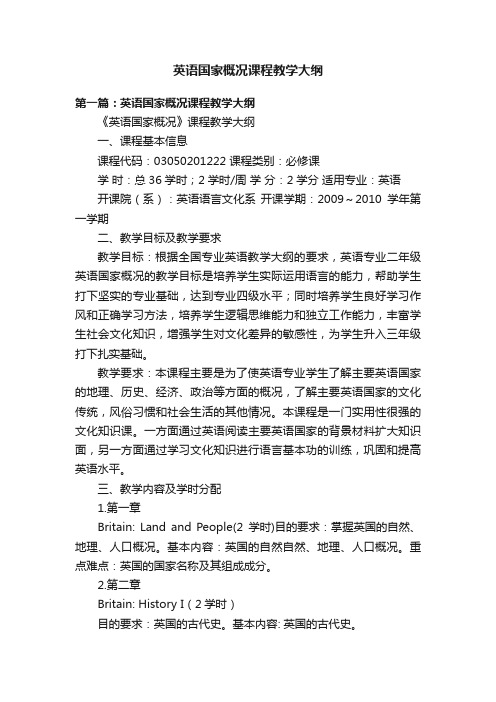
英语国家概况课程教学大纲第一篇:英语国家概况课程教学大纲《英语国家概况》课程教学大纲一、课程基本信息课程代码:03050201222 课程类别:必修课学时:总36学时;2学时/周学分:2学分适用专业:英语开课院(系):英语语言文化系开课学期:2009~2010学年第一学期二、教学目标及教学要求教学目标:根据全国专业英语教学大纲的要求,英语专业二年级英语国家概况的教学目标是培养学生实际运用语言的能力,帮助学生打下坚实的专业基础,达到专业四级水平;同时培养学生良好学习作风和正确学习方法,培养学生逻辑思维能力和独立工作能力,丰富学生社会文化知识,增强学生对文化差异的敏感性,为学生升入三年级打下扎实基础。
教学要求:本课程主要是为了使英语专业学生了解主要英语国家的地理、历史、经济、政治等方面的概况,了解主要英语国家的文化传统,风俗习惯和社会生活的其他情况。
本课程是一门实用性很强的文化知识课。
一方面通过英语阅读主要英语国家的背景材料扩大知识面,另一方面通过学习文化知识进行语言基本功的训练,巩固和提高英语水平。
三、教学内容及学时分配1.第一章Britain: Land and People(2学时)目的要求:掌握英国的自然、地理、人口概况。
基本内容:英国的自然自然、地理、人口概况。
重点难点:英国的国家名称及其组成成分。
2.第二章Britain: History I(2学时)目的要求:英国的古代史。
基本内容: 英国的古代史。
重点难点:英国历史上主要的入侵者,如:盎格鲁·萨克逊人;诺曼征服及其影响。
3.第三章Britain: History II(2学时)目的要求:英国的形成。
基本内容: 英国的形成。
重点难点:英国历史上的大宪章,百年战争,及其黑死病等重要历史事件。
4.第四章Britain: History III(2学时)目的要求:英国的近代史。
基本内容:英国的近代史。
重点难点:英国宗教改革,文艺复兴,英国内战,光荣革命。
英语国家概况课程教学大纲
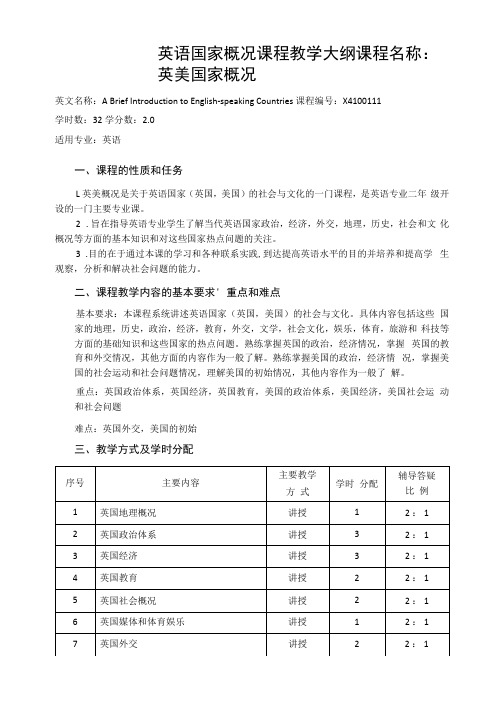
英语国家概况课程教学大纲课程名称:英美国家概况英文名称:A Brief Introduction to English-speaking Countries课程编号:X4100111学时数:32学分数:2.0适用专业:英语一、课程的性质和任务L英美概况是关于英语国家(英国,美国)的社会与文化的一门课程,是英语专业二年级开设的一门主要专业课。
2.旨在指导英语专业学生了解当代英语国家政治,经济,外交,地理,历史,社会和文化概况等方面的基本知识和对这些国家热点问题的关注。
3.目的在于通过本课的学习和各种联系实践,到达提高英语水平的目的并培养和提高学生观察,分析和解决社会问题的能力。
二、课程教学内容的基本要求' 重点和难点基本要求:本课程系统讲述英语国家(英国,美国)的社会与文化。
具体内容包括这些国家的地理,历史,政治,经济,教育,外交,文学,社会文化,娱乐,体育,旅游和科技等方面的基础知识和这些国家的热点问题。
熟练掌握英国的政治,经济情况,掌握英国的教育和外交情况,其他方面的内容作为一般了解。
熟练掌握美国的政治,经济情况,掌握美国的社会运动和社会问题情况,理解美国的初始情况,其他内容作为一般了解。
重点:英国政治体系,英国经济,英国教育,美国的政治体系,美国经济,美国社会运动和社会问题难点:英国外交,美国的初始三、教学方式及学时分配四、课程其他教学环节的要求.要求改变以教师为中心的教学模式,注重培养学生的学习能力和研究能力,采用多种教学方式,除课堂教学外还要安排学生看录像片和相关书籍,布置讨论题目。
1.学生要主动,全面的预习课文,积极配合教师完成课堂教学,课后要阅读相关书籍报纸杂志关于英国和美国的热点新闻,扩展知识面,能积极思考,参与讨论,并能提出问题。
最后做出全面的复习。
五,本课程与其他课程的联系先修课程:综合英语(学生在对英美国家的社会文化背景有了初步的了解之后可以更好的学习掌握英美概况的相关知识)后续课程:英美文学(对英美国家概况知识有了充分的了解之后才能更好的学习英美文学)六'教学参考书目《英语国家社会文化与入门》上下册朱永涛主编高等教育出版社1998年1月第一版《英美文化基础教程学习手册》朱永涛主编外语教学与研究出版社1994年6月第一版《英美文化辞典》胡文仲主编外研社1995年10月第一版《世界文化史故事大系》英国卷毕继万主编上海外语教育出版社2003年2月第一版《世界文化史故事大系》美国卷倪世雄乔长森主编上海外语教育出版社2003年2月第一版。
英语国家概况 课程教学大纲 教案
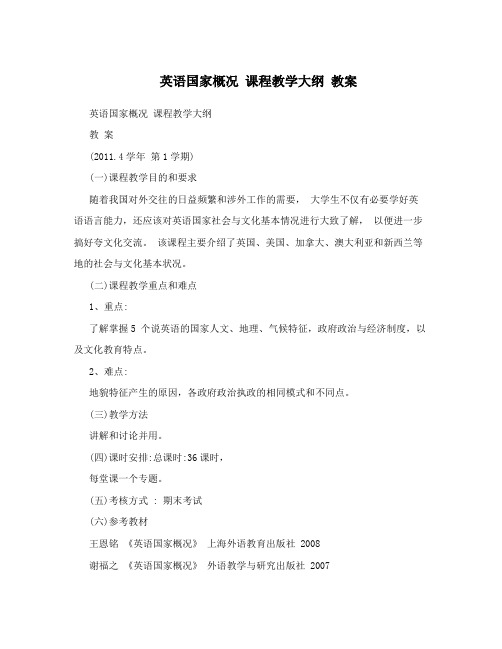
英语国家概况课程教学大纲教案英语国家概况课程教学大纲教案(2011.4学年第1学期)(一)课程教学目的和要求随着我国对外交往的日益频繁和涉外工作的需要,大学生不仅有必要学好英语语言能力,还应该对英语国家社会与文化基本情况进行大致了解,以便进一步搞好夸文化交流。
该课程主要介绍了英国、美国、加拿大、澳大利亚和新西兰等地的社会与文化基本状况。
(二)课程教学重点和难点1、重点:了解掌握5 个说英语的国家人文、地理、气候特征,政府政治与经济制度,以及文化教育特点。
2、难点:地貌特征产生的原因,各政府政治执政的相同模式和不同点。
(三)教学方法讲解和讨论并用。
(四)课时安排:总课时:36课时,每堂课一个专题。
(五)考核方式 : 期末考试(六)参考教材王恩铭《英语国家概况》上海外语教育出版社 2008谢福之《英语国家概况》外语教学与研究出版社 20071教学日历(语1-4’c )周星时授授课内容课外作业、参考书目书课教材页序名、章节、起教学大纲的章节、题目、形号、题序号止页码内容,章节、起止页码次期数式22 Mon.Wedn.Fri. 2 讲 P2-8 Part One : Geographic features of课 UK3 Mon.Wedn.Fri. 2 讲 P12-41 Part Two: The people and history课 4 Mon.Wedn.Fri. 2 讲 P42-61 Part three: Government and politics课 5 Mon.Wedn.Fri 2 讲 P81-99 Part four: Religion and education 课 6 Mon.Wedn.Fri 2 讲 Part five: Geographic features of 课 P 114-123 USA 7 Mon.Wedn.Fri. 2 讲国庆休假、实习课 8 Mon.Wedn.Fri 2 讲课9 Mon.Wedn.Fri 2 讲课 10 Mon.Wedn.Fri 2 讲P 124-155 Part Six: History and American课 P145- 154 identity11 Mon.Wedn.Fri 2 讲P156-175, Part Seven: Political situation and课 178-187 social service 12 Mon.Wedn. Fri 2 讲P188- 205 Part eight: Legal system, education 课 and Religion in American life 13 Mon.Wedn.Fri 2 讲P 226-238Part Nine : The Land and people of 课Canada 14 Mon.Wedn.Fri 2 讲Part Ten: History and culture life 课 15 Mon.Wedn. Fri 2 讲P239,262,271 Part Eleven: The land and people of课 P284-305 Australia16 Mon.Wedn.Fri 2 讲 Part Twelve: Government, politics, 课 P317-338 culture life 17 Mon.Wedn.Fri 2 讲 Part thirteen: The land and the 课P340 people of New Zealand 18 Mon.Wedn.Fri 2 讲Part fourteen: History and political 课 P349-360system 19 Mon.Wedn.Fri 2 讲Review 课Lecture One Geography of U K Question for discussion:1) Where does Britain lie?2)What is its full name?33)What is the total land area of the United Kingdom?4)What is British Isles?5)How long does its coastline run?1. Geographic features and its total area.:Britain is situated in Western Europe and is separated from the European continent in the east by the North Sea, the Strait of Dover and the English Channel in the south. It is an insular(保守的)country. Its coastline runs 12,429 km, It is one of the countries with longest coastline. To thewest of it lies the Atlantic Ocean, across and beyond it is America. The Straits of Dover between France and England is quite narrow and itis 33 km across. In 1985 the British government and the French government decided to build a channel tunnel under the Straits of Dover so that England and France could be joined together by road. Thischannel tunnel was opened to traffic in May 1994 after eight years hard work.The Britain faces Scandinavia Peninsular (Norway, Sweden and Denmark) to the northeast and to the North lies Iceland To the south across the English Channel lies France and Belgium and to the east across North Sea lie Germany and Holland.The total area is about 244,820 square kilometers.It Is over 1,000 km. from south to north and it is about 500 km.from west to east.2. The names of UKIts full name is the United Kingdom of Great Britain and Northern Ireland, usuallyshortened , abbreviated to the United Kingdom or U.K.. It may also called Great Britain, Britain or informally England.England: 130.000skm, 60% of whole island.British Isles: Two large islands and several small onesBritain:The United Kingdom of Great Britain and Northern Ireland.Great Britain :England, Wales, ScotlandBritain is divided into highland area and lowland area.It has large mountain ranges : the Pennies :Bulk of Pennines(奔宁山脉) is moorland.The Cumbrian Mountain Range, the Grampian Mountains , the Cambrian Mountain Range and such important rivers as Thames River ,the Seven River, Mercy River, the Humber, the Clyde River and the Forth.Scotland has an area of 78,760 square kilometers in northern part.It is situated in the north of Great Britain with a good number of mountains and islands. There are 800 islands which contain Hebrides, Shetland and Orkney islands. Edinburgh is the capital of Scotland.Wales: Wales is in the west of Great Britain. It has an area of20,761 square kilometers and it take up less than 9% of the whole island. The capital of Wales is Cardiff. Most of Wales is mountainous. The hills rise steeply from the sea and rather flat on top. 6% of Wales is covered with forest and much of the country is pastureland for sheep and cattle. Wales on the WesternProminence. 20.700skm, 9% of the whole island.Wales was united to England in 14th centuryNorthern Ireland takes up the northern fifth of Ireland. It has an area of 14,147 square kilometers. It is made up of six counties that consist of fertile, drumlin [`dr?mlin] (鼓丘) countrysurrounding Lough Neagh. Belfast is the capital of Northern Ireland. Mountains in the north4and south, separated by the fertile basin of Lough Neagh, mainly agricultural, industrial center: two ports– Belfast and Londonderry.3. Climate and Weather ------A maritime type of climate:1) moderated by the Atlantic Gulf Stream, milder than places in the same latitude. 2) equable: winters are mild, temperature exceed 4c inthe west, lower in the east. July about 18c. 13c in the northern Scotland.3) changeable day-t-day conditions.4) Rainfall throughout the year. No marked dry season.In Britain the weather is rainy, changeable and unpredictable. In fact it has a favorable maritime climate. It rarely rises above 32? in summer or falls below –10? in winter. Wintersare mild, not too cold and summers are cool, not too hot.― Can I compare thee to the summer‘s day ?‖Rainfall: Britain has a steady reliable rainfall throughout the whole year. The average annual rainfall in Britain is over 1,ooo mm.It is rainy and so changeable and unpredictable. One can experience four seasons in the course of a single day. Britain is famous for its fogs. The smoke-fogs of the big town, which used to develop in winter time whenever there was not enough wind to blow the smoke away, were horrible, unhealthy and dangerous to movement4. Rivers and lakes and natural resourcesThere are many lakes and rivers in England: but not very large.1) the longest river: Severn River, 355km2) Thames River, 338km, in Oxford3) Clyde River in Scotland4) lakes lies in Northern Scotland & the Cambria Mountains and North Wales England is rich in coal, iron, tin, copper, oil and gasThere are no large land-based oilfields except in North Sea. (also gas)5. Exercise:Tell if the following are true or false1) The island of great Britain is geographically divided into three parts: England , Scotland and Wales. ( + )2) People in different parts of Britain like to use the name Englandto refer to their country. ( - )3) Today more than half of people in Wales still speak the ancient Welsh language.( - ) 4) In terms of population and area, NorthernIreland is the second largest part of the United Kingdom. ( - )5) The longest river of Britain originates in Wales. ( + )6) Because of political troubles, Northern Ireland has been quite significant among the four constituent parts of the United Kingdom. ( + )7) Though the climate in Britain is generally mild, the temperaturein Northern Scotland often falls below -10‘c in January. ( - )8) The two main islands of the British Isles are Great Britain and Ireland. ( + )59) Cardiff is the capital city of Scotland. ( - )10) According to a 2005 census, Britain now has a population of 60 million. ( + ) 11) Among the four parts of United Kingdom, Wales is the smallest. ( - ) 12) English belong to the Germanic group of Indo-European family of language. ( + ) 13) Almost a quarter of the Britishpopulation lives in northwestern England. ( - ) 14) The introduction of Christianity to Britain added the first element of Latin and Greek words to English. ( + )15) The evolution of Middle English was reinforced by the Norman influence. ( + )Lecture Two The People(1)Question for discussion:1) What are the Celtic languages? Are they still alive?2) How has English language evolved in history? Is it important tothe UK‘s class structure?3) What are the minor languages spoken in the UK,Overview: Population: 56,500,000English 80%; Welsh 5%; Scots 10%; Irish 4%.1. The English: Anglo-Saxon in origin, Germanic tribes conquered in the 5th, 6th AD. Norman French, Under William of Normandy in 1066. Welsh, Scot, Irish: Celts from north-western Europe, invaded Britain between700BC and 200BC.1.1 The characteristics of English people: reserved, unemotional, courteous; shy of strangers; suspicious of change and slow to accept new ideals; solid and dependable with a high sense of honesty, duty and justice; physically and morally courageous; conscious of his place inthe social order, disliking any show of emotion and lack of control.2. The Welsh is composed of two groups of people:1) sheep farmers in the mountainous regions of the centre and north;2) industrial workers in the south2.1 Characteristics of Welsh people: musical, emotional, cheerful, proud of their past, and welcoming to friends but suspicious of foreigners. They lived hard-working lives of the Welsh The culturalpride in Wales is very strong, famous for their love of music and poetry. Welsh is an ancient Celtic language, more different from English than English is from French or German.3. Characteristics of the Scots: inventive, hard-working, serious-minded and cautious withmoneyA) Highlanders live by farming sheep and fishing, being proud, independent, hardy B) Lowlanders live in industrialized urban areas.2) Great empire builders, fierce soldiers . ―Devils in skirts‖ or―ladies from hell‖ are nicknames ofScottish soldiers for their bravery.3) Distinctive national dress: kilt, pleated skirts( 百折裙)4.Characteristics of Irish: introspective(好反省的) dreamers and poets, argumentative and6aggressive.1) IRA: the Irish Republican Army on the Catholic side. 2) Ulster Unionists, (Loyalists) on the Protestant side.5 . Immigrants:1) escape political or religious persecution2) seek a better life3) A) from old dominions of Canada, Australia, New Zealand, South AfricaB) Eastern European refugeesC) West Indies, India & PakistanD) Chinese, Greek, Turkish Cypriots, Italian, Spaniards Emigration from Britain to Canada and Australia, USA (doctors, scientists) ---- “brain drain‖6. The Origins of a Nation6.1. early settlement (---55BC)A) the first immigrants: Iberians from Spain & Portugal about 5000 years ago.their relics: Stonehenge 石林(stone monuments) on Salisbury Plain in southwest of England.B) 3 waves: Celts from north-west Europe after 700 BC., 500 BC, and 100 BC — tall, red hair and blue eyes.C) Celtic conquerors blended with Iberian6.2. Roman Britain (55BC –410)1) Julius Caesar came to Britain in 55BC.2) Roman occupation lasted about 400 years.6.3 Impacts on its culture1) brought Christianity to England2) built roads all across Britain3) towns grew up along the Roman roads4) English upper classes became completely Romanized, Roman landowners and officials.5) Social systems: laws, taxes6) Roman language---Latin7) system of writing & numbering8) written description of the land, peoples9) engineering skills, architecture7. Anglo-Saxon times (446-871)Three Germanic tribes invaded England: Angles, Saxons and Jutes. The name England is namedafter Angles.7.1. Danish InvasionAt the turn of 8th century, Danes, or Vikings, invaded England from Norway & Denmark.8. NormansThe Norman Conquest in 1066.78.1 Consequences: William of Normandy and his French-speaking followers set up a strong central government which brought a new unified discipline and control to England. 8.2. French became the official language.8.3. established a feudal system.8.4. Contacts between England & France increased.Exercises:1. Decide whether the following are true or false:1) The British history before 55BC is basically un documented. (+)2) The name of Britain came from a Celtic tribe ---the Britons. (+)th3) The Anglo-Saxons came to Britain in the mid 5 century. (+) th4) The Vikings began to attack the English coast in the 8 century.(+).2. Choose the best answer:1) The ____ attack on Roman ended the Roman occupation in Britain in 410.A. NormanB. DanishC. CelticD. Germanic (d)th2) By the late 7 century, _____ Christianity became the dominant religion in England.A. CelticB. Anglo-SaxonC. GermanicD. Roman (d)Part I Politics Feudal EnglandRecorded history in Britain began in the year 55BC, when Julius Caesar and his Roman troopsththinvaded the island. Between the 8 and 5 centuries BC, the Celts inhabited the island and becamethe dominant residents. The name Britain came from the Britons, a Celtic tribe. In 43AD, Britainthsubsequently became a Roman province and it remains so until the beginning of the 5 century.Many of the native Celtic were driven to the mountainous region of Scotland and Wales, which remain unconquered by the Romans. The Roanswere excellent builders and they constructed towns and cities which prospered far longer than any previous settlements on the island. In 410, Germanic barbarians attacked Roman, forcing all Roman troops to leave Britain, which ended the Roman occupation of the island. These warriors included the Angles, the Saxons and Hutes. From that time on, English, the language of the Angles, replaced the old Celtic language as the dominant language of the land. As the Anglo-Saxon were not Roman Christian, St. Augustine was sent to Britain to convert the Anglo Saxon people in 587 with 40 missionaries. They converted many Anglo-Saxons to Roman Christians. Augustine founded a church and a monastery in Canterburythand became the first Archbishop of Canterbury in 601. By the late7 century Roman Christianitythbecame the dominant religion in Britain. In the 8 century the Vikings from the Scandinaviancountries of Northern Europe to attack the English coast. The seven Anglo-Saxons= kingdom in England gradually united under Alfred the Great. In 1042, Edward the Confessor,, as a piousChristian, built Westminster Abbey, which exists today. On September 28, 1066, William crossed the channel with a formidable army. His army defeated the English army King Harold (brother in law of Edward) at the battle of Hastings. and began the Norman Conquest of England, which marked the establishment of feudalism in England.By the year 1154, Henry II, William‘s great grandso n, ascended the throne and thus began therule of the House of Anjou(also known as (the House of Plantagenet). Henry II is best remembered for his reform of the courts and the laws, He improved the courts of justice,8introduced the jury system and institutionalized common law. After Richard I, son of Henry II, was killed in France, his brother John ascended the throne in 1199. He was defeated in a war in France and lost Normandy in 1204. Dissatisfied with John‘s leadership, the lords forced him tosign the Magna Carta(大宪法), which is regarded as the foundation of the Britishconstitutionalism and it provides the basic principles for the protection of individual rights. P15 The Hundred Years War (1337-1453) was a series of wars between England and France over trade, territory, security and the throne. This war had significant impact on the English society. It promoted the English concept of nationalism and promoted the development of the textile industry.The War of the Roses was a series of Civil War between two great noble families: the House of York, whose badge was a white rose, and the House of Lancaster, whose badge was a red rose. Both houses battled for power, wealth and ultimately the throne. in the end , the House of Lancaster won and their leader Henry Tudor became King Henry VII andstarted the rule of the House of Tudor, an efficient centralized government.1. Under William’s rule, the Normans changed England to a feudal state under an absolute kingship.2. King Arthur: in 6th, the central figure of many legends about him and his Knights of round Table.3. the Magna Carta– Great Charter, a document signed in 1215 byKing John, to recognize the rights of barons.4. Hundred Years’ War: between England & France from 1337 to 1453in France. French drove English partly through the inspiration of Joan of Arc (a French saint & national heroine), partly through the effective use of guns.5. Wars of the Roses: struggle for the throne of England (1455-1485)between . The houses of Lancaster, whose badge was a red rose, and York, a white rose. Impacts: the war weakened both nobility and the monarch.6. The Black Death: a deadly bubonic plague(淋巴腺鼠疫), struck Europe in middle of 14th,reached England in 1348. ? of the population died.7. Religious Revolution1) the Catholic Church:A) headed by the Pope;B) members accept the gospel of Christ and the teachings of the Bible.C) Any revolt against the traditional Christian faith was “heresy”.D) in the Middle Ages, Pope was powerful2) Protestant Church:A) whose faith and practice originated with the principles of the Reformation. B) Pope’s political power and religious authority declinedin 16th, Protestant churches sprang up in Northern Europe, and in the Elizabethan age, became gradually the do minant faith. 3) Henry VIII’s divorce question, married his brother’s widow, a Spanish princess, who gave adaughter, Mary, not a son.4) Bloody Mary: a devout Catholic, burnt so many protestants; succeeded by Elizabeth I. 5) Elizabethan age: literary achievement, Shakespeare, an age of adventure on the sea.There was an inevitable conflict between the Roman Catholic Churchand the King of9England who had established absolute monarchy. At that time , theonly person who could grant a divorce was the Pope. So Henry VII started the Reformation movement by declaring a break with Rome. He carried outa wholesale suppression of the monasteries and declared himself to bethe ―only supreme head of the church( in his Act of Supremacy in 1534). The Reformation was in essence a political movement in a religious guise.Part II The English Civil War1. a bitter power struggle (1642-1648) between the monarchy and Parliament.2. the victory of the Parliament led to the execution of Charles I in 1649, and the temporary overthrow of the monarchy.3. a republic founded by Oliver Cromwell for more than ten years.4. King Charles I: divine rights to govern,Ruled without parliament, levied taxes without parliament’s approval.5. Cromwell: Roundhead leader, defeated the King Charles I.The Glorious Revolution1. in 1688, Catholic king James II fled to France.2. the throne was offered to his Protestant daughter and her husband Dutch king William.3. the Bill of Rights was passed by Parliament to restrict the power of the Monarchy.4. beginning of the Constitutional Monarchy in Britain.5. Since then every English monarch rules by permission of Parliament.6. the theories of divine or hereditary right to the throne were ended.7. Bloodless Revolution7.Background:7.1. The 18th century saw ascendancy of the middle class in the life of the nation, with the development of commerce & industry.7.2. Glorious Revolution established the authority of middle class over the crown. 7.3. The union of Scotland and England into the nation of Great Britain --- the Act of Union of 1707.7.4. The Seven Years’ War (1756-63) in North America (French and India War) --- which left Britain predominant in North America and in India, Britain became the world’s leading colonialpower.7.5. In the 2nd half of the 18th century, the great economic and social changes were taking place in Britain --- agricultural and home-based trades and industries gradually gave way to factory-based industries with complex machinery.7.6. England was a great trade nation, with much private capital ready for investment. Not only was trade free to move throughout the British Isles, but also there was freedom of movement between the social classes. Middle class values encouraged self-reliance and enterprising initiative.7.8. Political leaders were interested in commerce. The growing population provided a market. Farmers‘ improved methods of cultivation freed much labor, which became available for employment in the town factories, and also increased food supplies for towns. 7.9 18th century was a time of peace and stability. Foreign plunder, the newly acquired wealth10after 7 years’war. Industrial Revolution first began in the textile industry, which was accelerated by important mechanical inventions ---- flying shuttle, spinning jenny, especially the steam-engine by James Watt in 1769.Results1. Factories came into being because they brought about more profits to the owners.2. New cities sprang up, population was concentrated in towns and cities.3. The power of influence of industrial capitalists grew greater.4. It gave birth a new social-economic class – proletariat who were exploited cruelly.5. It brought many economic advantages to Britain and made Britain rich and powerful. Chartist MovementThe Chartist Movement (1836-48): the industrial and commercial classes, with the support of the working classes, demanded to reform the old voting system.Exercise:Tell whether the following are true or false:1) The Magna Carts was designed to protect the rights of both the privileged class and thetownpeople. (-)2) The Hundred Years‘ War was a series of wars fought between England and Normans for tradeand territory. (-)3) Westminster Abbey was built at the time of Edward the Confessor. (+)4) The Norman Conquest marked the establishment of feudalism in England. (+) 5) The end of the Wars of Roses led to the rule of the House of Tudor (+)6) The direct cause for the Religious Reformation was King HenryVIII‘s efforts to divorce hiswife. (+)Lecture Three Government System P31A nation of Constitutional Monarchy1. The Monarch respects the Constitution.2. In law, the monarch is head of the executive, an integral part of the legislature; head of the judiciary; commander-in-chief of3. In the Glorious Revolution, William and Mary became the joint rulers of Britain, and the Constitutional Monarchy began.4. The Bill of Rights which was passed in 1689 restricted the power of the monarchy.The British Constitution1.1. It is unwritten1.2. Its components include Acts of Parliament, the Prerogative of the Crown, Conventions of the Constitution, Common Law and Parliamentary Privilege.1.3. It is more flexible than the written ones in other countries.2. Conventions of the Constitution2. 1. They form an important part of the Constitution just aswritten laws do. 2. 2. They are rules which are not written down but which everyone agrees must be followed in11practice.2. 3. They include the following:1) the powers of the Crown are exercised mainly by Ministers;2) the Queen must act on the advice of Ministers;3) Ministers are responsible to parliament for their actions;4) the sovereignty of Parliament3. Common Law3. 1. It is one of the main components of the British Constitution.3. 2. It refers to the Bills which have been passed by courts.3. 3. It marked a sharp decline in powers of the Monarch.4. The Bill of Rights4. 1. It was the Bill passed by the Parliament in 1689 after the Glorious Revolution. 4. 2. It laid down a number of things that future monarchs could not do. 4. 3. It marked a sharp decline in powers of the Monarch.4. 4. It marked the beginning of the British Constitutional Monarchy5. General Election5. 1. General Election is held at least every five years.5. 2. The country is divided into 635 constituencies, each of which returns one Member of Parliament.5. 3. The one who has the most votes in a constituency becomes a Member of Parliament. 5. 4. The leader of the party with the largest number of members returned to the House of Commons becomes Prime Minister.6. Party system in Parliament6. 1. The leader of the party with the largest number of members returned to the House of Commons becomes Prime Minister and is invited by the Queen to form a government; 6. 2. The party with the next largest numbers of supporters in the Commons becomes the official Opposition to Government.6. 3. The Prime Ministers and other ministers sit on the7. Political Parties7. 1. The UK has a two-party system.7. 2. The Conservative is major right-wing party.It supports free enterprise and is generally opposed to nationalization and to extending the social services. So conservatives are those who have something to conserve and they usually hate the great changes in society.It believes actively in the pursuit of greater social and economic equality. The Labor Party is a party of moderate socialism in favor of Nationalization of key industries. It has always been anti-Communist, supported by some middle class and intellectuals. It is also a main party for working class people.It draws most of its support from highly urban and industrialized people.127.3 . The Liberal Party is the third largest political party since 1922. 7.4. The Social Democratic Party was formed in 1981 by a small number of right-wing Labor party politicians.8. British Parliament8.1. It includes 3 elements:1) the Crown;2) the House of Lords;3) the House of Commons8.2. It is the supreme law-making authority in Britain.8.3. The real center of parliamentary power is in the House of Commons. 8.4. Other functions:1) to control and criticize the executive government;2) to control the raising and the spending of money.9. The House of Lords9.1. Its members are peers, most of whom are hereditary.9.2. Its powers have been severely reduced by the Parliament Acts of 1911 and 1949. 9.3. It must pass all financial legislation sent to it from the House of Commons, and can delay other Bills for only one year.9.4. It has a special judicial function.9.5. The Lord Chancellor=Speaker10. The House of Commons1). It consists of 635 elected Members of Parliament.2.) MPs have a number of privileges, eg. The freedom of speech in Parliament. 3). it is by far the most powerful and important element in Parliament, therefore plays the key role in the activities of Parliament as a whole.4.) The Speaker presides over the meeting in the House of Commons.Exercise:1. Answer the following questions:1) Which of the following is just rules and p ractices, but don‘t exist legally?A. Statutory LawB. Common LawC. Conventions2)The constitution can be altered or amended by Monarchy, so it is subjects to different bodies, like politicians, judges and scholars. right? *3) Who is the head of the executive branch ____? A. legislature,B .executive C. judiciary 4) Parliament consists of the king or Queen, the house of Lords and the House of Commons. Is it right?5) Prominent bishops of the church of England are included in the House of Lords? (yes) 6) What‘s the legislative function of the House of Lords? to examine the revise bills. 7). How often is a general election of the government held? 58). Which of the two Houses has the power of drafting new laws?9). The one important function of the House of Commons is scrutinize or restrain the actions of。
《英语国家概况》教学大纲

《英语国家概况》教学⼤纲《英语国家概况》教学⼤纲An Outline Introduction to Britain and America学时:36学时学分:2分层次:本科⼆年级适⽤专业:英语专业第⼀部分⼤纲说明⼀、课程的性质、⽬的和任务英语国家概况是⼀门⽂化知识性课程,主要以英语为媒介系统阐述世界主要英语国家基本概况的学科,是⾼等学校英语专业本科⽣的必修课程之⼀。
教学主要以英语为凭借,全⾯⽽系统地向学⽣介绍世界主要英语国家的基本概况,从⽽使学⽣系统地了解这些国家的地理、历史、⽂化、宗教、社会⽣活、政治制度、经济状况等⽅⾯的情况来培养学⽣的跨⽂化交际能⼒,同时也可以促进加强学⽣的语⾔学习,并以批判的眼光分析历史事件。
⼆、课程的基本要求通过本课程的学习,要求学⽣对以下⼏个⽅⾯有初步了解:1、地理概况、⽓候特征、⾃然灾害2、历史进程、社会变迁、⼈⼝发展3、政治制度、经济系统4、⽂化、教育、宗教、节⽇三、本课程与相关课程的联系本课程作为英语国家的背景知识课程,对于学⽣理解英语⽂化和语⾔具有重要意义,与英语泛读课程的联系较为紧密。
四、学时分配本课程的教学时间为36学时,安排在第四学期,每周2学时,本课程的教材选⽤《新编英美概况教程》(第⼆版),周叔麟、﹝美﹞C.W. Pollard,June Almes 主编,北京⼤学出版社;并辅以英美重要⽂献资料的阅读和分析。
整个教学顺序五、教材与参考书教材:《新编英美概况教程》(第⼆版),周叔麟,﹝美﹞C.W. Pollard,June Almes 主编,北京⼤学出版社,2010年5⽉出版。
教学参考书:1.Davidson, James. Nation of Nations. McGraw Hill, 4th edition, 2006.2. Grafton, John Edited. The Declaration of Independence and Other Great Documents of American History 1775-1865. Dover Publications, Inc. 2000.3. Zinn, Howard. A People's History of the United States: 1492 to Present. Harper Perennial Modern Classics, August 2, 2005.4.来安⽅编著,张克定校订,《英美概况》(新增订本),郑州:河南⼈民出版社,2007年8⽉.5.马丁·吉尔伯特著,王⽟菡译,《美国历史地图》,北京:中国青年出版社,2009年.6.马丁·吉尔伯特著,王⽟菡译,《英国历史地图》,北京:中国青年出版社,2009年.7.余志远主编《英语国家概况》,北京:外语教育与研究出版社,2000年.课外阅读部分:英国部分:《⼤宪章》、《权利法案》美国部分:《独⽴宣⾔》、《美国宪法》、《⼈权法案》、《解放⿊⼈奴⾪宣⾔》六、教学⽅法与⼿段建议该课程的教学应遵循以下原则:6.1系统性原则:以系统思想为依据,将整个历史部分的教学过程视为⼀项系统⼯程,采⽤系统⽅法和⼿段,对教学过程的各个环节以及与教学相关的因素进⾏系统分析,对教学的内容和程序予以系统设计,以求在现有的条件下达到最佳教学效果。
英语国家概况教学大纲
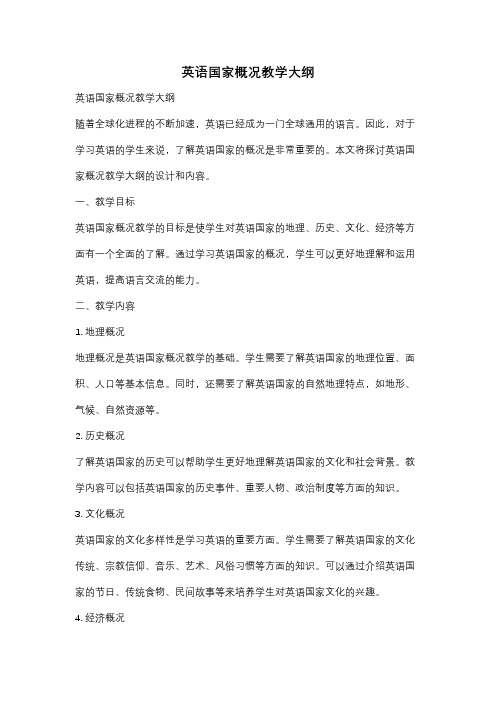
英语国家概况教学大纲英语国家概况教学大纲随着全球化进程的不断加速,英语已经成为一门全球通用的语言。
因此,对于学习英语的学生来说,了解英语国家的概况是非常重要的。
本文将探讨英语国家概况教学大纲的设计和内容。
一、教学目标英语国家概况教学的目标是使学生对英语国家的地理、历史、文化、经济等方面有一个全面的了解。
通过学习英语国家的概况,学生可以更好地理解和运用英语,提高语言交流的能力。
二、教学内容1. 地理概况地理概况是英语国家概况教学的基础。
学生需要了解英语国家的地理位置、面积、人口等基本信息。
同时,还需要了解英语国家的自然地理特点,如地形、气候、自然资源等。
2. 历史概况了解英语国家的历史可以帮助学生更好地理解英语国家的文化和社会背景。
教学内容可以包括英语国家的历史事件、重要人物、政治制度等方面的知识。
3. 文化概况英语国家的文化多样性是学习英语的重要方面。
学生需要了解英语国家的文化传统、宗教信仰、音乐、艺术、风俗习惯等方面的知识。
可以通过介绍英语国家的节日、传统食物、民间故事等来培养学生对英语国家文化的兴趣。
4. 经济概况了解英语国家的经济情况对于学生了解英语国家的社会发展和就业机会非常重要。
可以介绍英语国家的主要产业、经济发展水平、国际贸易等方面的知识。
三、教学方法1. 多媒体教学多媒体教学是英语国家概况教学的重要手段。
通过使用图片、视频、音频等多媒体资料,可以生动形象地展示英语国家的地理、历史、文化、经济等方面的信息,激发学生的学习兴趣。
2. 小组讨论小组讨论是培养学生合作意识和思维能力的有效方法。
可以将学生分成小组,让他们在小组内讨论英语国家的某一方面,并向全班做报告。
这样可以增加学生的参与度,提高他们的口语表达能力。
3. 实地考察实地考察是英语国家概况教学的一种拓展方式。
可以组织学生参观英语国家的使馆、文化机构、企业等,让他们亲身体验英语国家的文化和社会环境。
四、教学评估教学评估是英语国家概况教学的重要环节。
英语国家概况大纲
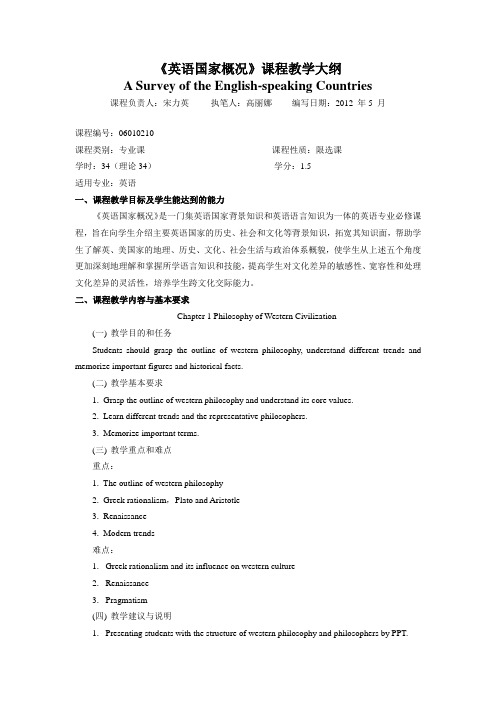
《英语国家概况》课程教学大纲A Survey of the English-speaking Countries课程负责人:宋力英执笔人:高丽娜编写日期:2012 年5 月课程编号:06010210课程类别:专业课课程性质:限选课学时:34(理论34)学分:1.5适用专业:英语一、课程教学目标及学生能达到的能力《英语国家概况》是一门集英语国家背景知识和英语语言知识为一体的英语专业必修课程,旨在向学生介绍主要英语国家的历史、社会和文化等背景知识,拓宽其知识面,帮助学生了解英、美国家的地理、历史、文化、社会生活与政治体系概貌,使学生从上述五个角度更加深刻地理解和掌握所学语言知识和技能,提高学生对文化差异的敏感性、宽容性和处理文化差异的灵活性,培养学生跨文化交际能力。
二、课程教学内容与基本要求Chapter 1 Philosophy of Western Civilization(一)教学目的和任务Students should grasp the outline of western philosophy, understand different trends and memorize important figures and historical facts.(二)教学基本要求1. Grasp the outline of western philosophy and understand its core values.2. Learn different trends and the representative philosophers.3. Memorize important terms.(三)教学重点和难点重点:1. The outline of western philosophy2. Greek rationalism,Plato and Aristotle3. Renaissance4. Modern trends难点:1. Greek rationalism and its influence on western culture2. Renaissance3. Pragmatism(四)教学建议与说明1. Presenting students with the structure of western philosophy and philosophers by PPT.2. Learning quotations of these philosophers and help students to understand their ideas.3. Asking students to make a presentation.(五)教学内容§1-1 Introduction§1-2 Greek Rationalism§1-3 The Middle Ages§1-4 The Renaissance§1-5 Modern Philosophy§1-6 Modern Philosophical Trends§1-7 SummaryChapter 2 Geography of the United Kingdom(一)教学目的和任务Students should grasp the general features of British geography, the key feature --- water and four political regions, and memorize important terms and figures.(二)教学基本要求1. Grasp the general features of British geography and four political regions.2. Learn geographical history and the Commonwealth.3. Memorize important terms.(三)教学重点和难点重点:1. The general features of British geography2. Four political regions3. Water system4. The Commonwealth难点:1. Topography of the UK2. Geographical features of Scotland and England3. The geographical history(四)教学建议与说明1. Presenting students with the topography and four political regions by PPT.2. Helping students understand the features of British geography by a lot of pictures, evenvideos.3. Asking students to make a presentation.(五)教学内容§2-1 Introduction§2-2 General Characteristics of the UK§2-3 Water: the Key Geographical Features§2-4 Geographical History§2-5 Surface Features and Geography --- by Political Region§2-6 Current Situation§2-7 CommonwealthChapter 3 History of the United Kingdom(一)教学目的和任务Students should grasp the course of British history and the basic historical facts, and memorize important terms and key points.(二)教学基本要求1. Grasp the basic historical facts about British history.2. Remember key figures and key points in British history.3. Learn and remember the terms.(三)教学重点和难点重点:1. The course of British history2. Major historical events: the Civil War, the Reformation, the Glorious Revolution, theIndustrial Revolution, the First and the Second World Wars.3. Important historical figures4. The definition of important terms难点:1. The bourgeois revolution and the Reformation2. The British Empire and its decline3. The definition of important terms(四)教学建议与说明1. Presenting students with the course of British history and major historical events.2. Understanding historical events by learning the life of the important historical figures.3. Asking students to make a presentation.(五)教学内容§3-1 Prehistory to the Norman Conquest§3-2 The Making of a Nation: From the Norman Conquest to the Renaissance§3-3 The Tudors: Sea Power and Protestantism§3-4 Founding of the British Empire§3-5 England in Revolution: Representative and Constitutional Government§3-6 England in the Eighteenth Century: The Age of Reason§3-7 Napoleonic Wars and a Century of Slow Reforms§3-8 Nineteenth Century Imperialism§3-9 Twentieth-Century England: Crisis of IdentityChapter 4 British Economy(一)教学目的和任务Students should grasp the characteristics and development of British economy, understand the present economic policies and memorize important data.(二)教学基本要求1. Grasp the characteristics and system of British economy.2. Understanding economic dictators and basic economic structure.3. Memorize important data.(三)教学重点和难点重点:1. The characteristics and system of British economy2. The economic dictators and basic economic structure3. Taxation and other economic policies难点:1. Economic dictators2. Industrial structure3. Economic policies(四)教学建议与说明1. Presenting students with the structure of British economy and important economic dictators by pictures and charts.2. Helping students understand characteristics of British economy by examples of world-famous brands or products.3. Asking students to make a presentation.(五)教学内容§4-1 Introduction§4-2 Highlights of Britain's Economic Development§4-3 Britain's Prosperity Today§4-4 Britain's Economic System: A Unique Mix§4-5 Consumer Expenditure§4-6 Industrial Structure and Output§4-7 International Trade§4-8 Taxation and Public Spending§4-9 Economic PolicyChapter 5 British Culture(一)教学目的和任务Students should grasp the meaning of culture and the characteristics of British culture. Remember the representatives and major schools in British art, literature and music.(二)教学基本要求1. Grasp the characteristics of British culture.2. Learn representatives and major schools in British art, literature, and music.3. Memorize important terms.(三)教学重点和难点重点:1. The outline of British culture2. British arts, media, literature, social customs, sports and religion3. Representatives and their achievements难点:1. British arts and literature2. Religion(四)教学建议与说明1. Presenting students with the components of British culture by PPT.2. Learn representatives and their achievements by pictures and videos.3. Asking students to make a presentation.(五)教学内容§5-1 Introduction§5-2 The British People --- General Traits§5-3 Entertainment§5-4 ConclusionChapter 6 British Education(一)教学目的和任务Students should grasp the history and characteristics of British education, acknowledge a profile of British higher education and memorize important terms.(二)教学基本要求1. Grasp the history and characteristics of British education.2. Acknowledging the basic information of British higher education.3. Memorize important terms.(三)教学重点和难点重点:1. The history and characteristics of British education.2. The British higher education.难点:1. The history of Britain education2. Higher education and elite universities(四)教学建议与说明1. Presenting students with the history of British education using demonstrations and charts on PPT.2. Helping students grasp the outline of British higher education by introducing world-famous colleges and universities.3. Asking students to make a presentation.(五)教学内容§6-1 Introduction§6-2 Medieval England---Church and Class§6-3 Renaissance Education§6-4 Eighteenth Century---What Is Correct English§6-5 Nineteenth Century---Class Struggle and Change§6-6 Twentieth Century---Reform, Socialism and Conservatism§6-7 ConclusionChapter 7 Geography of the United States(一)教学目的和任务Students should grasp the general features of American geography, the physiographic subdivisions, energy and mineral resources, and memorize important terms and figures.(二)教学基本要求1. Grasp the general features of American geography and physiographic subdivisions.2. Learn geographical history, energy and resources.3. Memorize important terms.(三)教学重点和难点重点:1. The general features of American geography2. Physiographic subdivisions3. Living patterns难点:1. Topography of the US2. Physiographic subdivisions3. The geographical history(四)教学建议与说明1. Presenting students with the topography and Physiographic subdivisions by PPT.2. Helping students understand the features of British geography by a lot of pictures, even videos.3. Asking students to make a presentation.(五)教学内容§7-1 Introduction§7-2 Economic Activities§7-3 Rural, Suburban and Urban Living Patterns§7-4 Physiographic Subdivisions of the United States§7-5 Geologic Processes Shape the Nations Physical and Human Geography§7-6 Energy and Mineral Resources Required for a Modern Society§7-7 Summary: The United States---“A Land of Contrasts”Chapter 8 History of the United States(一)教学目的和任务Students should grasp the course of American history and the basic historical facts, and memorize important terms and key points.(二)教学基本要求1. Grasp the basic historical facts about American history.2. Remember key figures and key points in American history.3. Learn and remember the terms.(三)教学重点和难点重点:1. The course of American history2. Major historical events: the Independence War, the founding of the new nation, the Civil War, the Industrial Revolution, the First and the Second World Wars, the post-war period.3. Important historical figures4. The definition of important terms难点:1. The Independence War and the founding of the new nation.2. The Capitalism and Monopolies3. The definition of important terms(四)教学建议与说明1. Presenting students with the course of American history and major historical events.2. Understanding historical events by learning the life of the important historical figures.3. Asking students to make a presentation.(五)教学内容§8-1 Introduction§8-2 Native Americans§8-3 Colonial North America§8-4 The Founding of the United States§8-5 Forming A New Nation§8-6 Nationalism and the Economy Westward Expansion§8-7 The Industrial Revolution and Social Reforms§8-8 The American Civil War and Reconstruction§8-9 Industrialization,Capitalism,and Monopolies§8-10 The United States Becomes a World Power§8-11 The Post World War I Period§8-12 World War Ⅱ§8-13 The Post World War Period (1945- 1989)§8-14 Modern Times§8-15 ConclusionChapter 9 Britain and American Government(一)教学目的和任务Students should grasp the basic structure and departments of British and American governments, the similarities and differences between the two governments, and memorize important terms and key points.(二)教学基本要求1. Grasp the basic structure of British and American governments.2. Understand the features and functions of departments in the governments.3. Learn and remember the terms.(三)教学重点和难点重点:1. The basic structure and departments of British and American governments2. The similarities and difference3. Important political figures4. The definition of important terms难点:1. The core principles and structure of British and American governments2. The Checks and Balances3. The definition of important terms(四)教学建议与说明1. Presenting students with the structure of British and American governments by charts.2. Understanding the checks and balances by charts.3. Asking students to make a presentation.(五)教学内容§9-1 Introduction§9-2 Politics§9-3 Political Legitimacy§9-4 Absolutism and Constitutionalism§9-5 Democracy§9-6 Indirect or Representative Democracy§9-7 Elections§9-8 The Assembly Model§9-9 ConclusionChapter 10 The Economy of the United States(一)教学目的和任务Students should grasp the characteristics and development of American economy, understand the present economic policies and memorize important data.(二)教学基本要求1. Grasp the characteristics and system of American economy.2. Understanding economic dictators and basic economic structure.3. Memorize important data.(三)教学重点和难点重点:1. The characteristics and system of American economy2. The economic dictators and basic economic structure3. Taxation and other economic policies难点:1. Economic dictators2. Industrial structure3. Economic policies(四)教学建议与说明1. Presenting students with the structure of American economy and important economic dictators by pictures and charts.2. Helping students understand characteristics of British economy by examples of world-famous brands or products.3. Asking students to make a presentation.(五)教学内容§10-1 Introduction§10-2 Introduction and Overview§10-3 History and Growth§10-4 Commercial and Nonprofit Firms§10-5 Households§10-6 Government and the Economy§10-7 International Trade§10-8 Problems and Challenges for the U.S. EconomyChapter 11 American Society(一)教学目的和任务Students should grasp the characteristics of American society, understand the social conventions and values, and memorize important data.(二)教学基本要求1. Grasp the characteristics of American society.2. Understanding conventions and values.3. Memorize important terms.(三)教学重点和难点重点:1. The characteristics and system of American society2. The conventions and values难点:1. The conventions and values2. Social problems3. Race and ethnicity(四)教学建议与说明1. Presenting students with the characteristics of American society and social conventions by pictures and charts.2. Helping students understand American values by instances and cases.3. Asking students to make a presentation.(五)教学内容§11-1 Introduction§11-2 Individuals§11-3 Families§11-4 Groups§11-5 Organizations§11-6 Socioeconomic Classes, Status and Roles§11-7 Race and Ethnicity§11-8 Other Social IssuesChapter 12 American Culture(一)教学目的和任务Students should grasp the meaning of culture and the characteristics of American culture. Remember the features and main points in American food, manners and holidays.(二)教学基本要求1. Grasp the characteristics of American culture.2. Learn features and main points in American food, manners and holidays.3. Memorize important terms.(三)教学重点和难点重点:1. The outline of American culture2. American food, manners and holidays, social customs, sports and religion难点:1. Materialism2. Religion3. Manners(四)教学建议与说明1. Presenting students with the components of American culture by PPT.2. Learn manners and holidays by pictures and videos.3. Asking students to make a presentation.(五)教学内容§12-1 Introduction§12-2 Materialism and the Mass Media§12-3 Individual Style and Personal Rites of Passage§12-4 Manners§12-5 Food and Meals§12-6 Pets§12-7 Housing§12-8 Leisure Activities§12-9 HolidaysChapter 13 British Education(一)教学目的和任务Students should grasp the characteristics of American education, acknowledge a profile of American basic and higher education and memorize important terms.(二)教学基本要求1. Grasp the characteristics of American education.2. Acknowledging the basic information of American basic and higher education.3. Memorize important terms.(三)教学重点和难点重点:1. American basic education2. American higher education难点:1. The characteristics of Britain education2. Higher education and elite universities(四)教学建议与说明1. Presenting students with the characteristics of American education using demonstrations and charts on PPT.2. Helping students grasp the outline of American higher education by introducingworld-famous colleges and universities.3. Asking students to make a presentation.(五)教学内容§13-1 Introduction§13-2 Issues in American Basic Education§13-3 Higher Education§13-4 Conclusion三、习题、课程讨论及要求英美概况课程要求学生在课余进行英美国家文化相关资料搜索和整理,课堂授课以理论和知识讲授,学生讨论和总结汇报相结合的方式进行,学生还要通过一定的学习和广泛阅读完成对文化热点问题的相关学期论文。
《英语国家概况》教学大纲
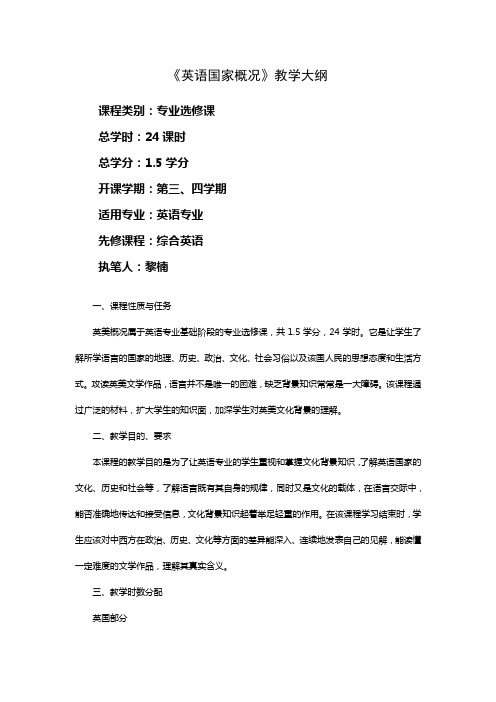
《英语国家概况》教学大纲课程类别:专业选修课总学时:24课时总学分:1.5学分开课学期:第三、四学期适用专业:英语专业先修课程:综合英语执笔人:黎楠一、课程性质与任务英美概况属于英语专业基础阶段的专业选修课,共1.5学分,24学时。
它是让学生了解所学语言的国家的地理、历史、政治、文化、社会习俗以及该国人民的思想态度和生活方式。
攻读英美文学作品,语言并不是唯一的困难,缺乏背景知识常常是一大障碍。
该课程通过广泛的材料,扩大学生的知识面,加深学生对英美文化背景的理解。
二、教学目的、要求本课程的教学目的是为了让英语专业的学生重视和掌握文化背景知识,了解英语国家的文化、历史和社会等,了解语言既有其自身的规律,同时又是文化的载体,在语言交际中,能否准确地传达和接受信息,文化背景知识起着举足轻重的作用。
在该课程学习结束时,学生应该对中西方在政治、历史、文化等方面的差异能深入、连续地发表自己的见解,能读懂一定难度的文学作品,理解其真实含义。
三、教学时数分配英国部分英国部分(上册)第一章:综述内容:从自然地理、自然资源、经济、人口和主要城市这几个方面讲述,使学生对英国有整体的认识课外作业:更多地了解英国的主要城市第二章:历史内容:本章从以下方面对英国历史进行讲述,英国的建立、中世纪的英国、封建制度的衰落、16世纪英国资产阶级的兴起、17世纪英国资产阶级革命、18世纪的英国工业革命、从自由资本主义到帝国主义、第一次世界大战与英国和第二次世界大战与英国课外作业:收集相关资料并掌握各部分知识点第三章:文化内容:从英国教育体系、传媒、体育、科学、文学以及历史文化古迹这几个方面详细介绍了英国的文化课外作业:重点比较英国与我国教育体系的相同和不同之处第四章:社会生活内容:本章重点讲述英国家庭和社会的习俗、礼仪,英国社会的工资和福利体系,以及英国的宗教信仰课外作业:充分了解英国的社会习俗第五章:政治制度内容:本章具体从以下几个方面进行讲述,英国的君主立宪政体,英国的宪法,英国的议会、内阁、首相与政府机构,以及英国的两党制和司法机构课外作业:就英国的政治制度写一篇1000字左右的论文第六章:文学内容:通过教学使学生掌握英国文学发展的几个重要历程和主要代表人物与代表作,以及英国文学其他方面的现状。
教学大纲

《英语国家概况(1)》课程教学大纲第一部分课程教学基本要求英语国家概况(1)是有关英语国家(英国、爱尔兰和澳大利亚)的社会与文化背景的课程。
旨在帮助学生了解这些国家的社会与文化概况,如地理,历史,政治,经济,教育体制, 社会生活和文化传统等方面的基本知识。
同时,通过课文的学习和各种练习的实践,帮助记忆各种信息,巩固和提高文化和语言高知识,帮助复习、归纳所学内容,达到提高英语水平的目的。
第二部分各章教学内容及教学要求英国部分:第一单元英国简介I(A Brief Introduction to the United Kingdom)(建议2课时)一、教学目的通过本单元学习,掌握英国的全称,它的几个构成部分,不列颠被征服的历史,并对其4个组成部分的历史、地理、现状等有个简要了解。
二、教学内容与要求1. 1. A complicated country with a complicated name (复杂的名称,复杂的国家)2. 2. The effects of its imperial past (帝国主义历史的影响)3. 3. A multiracial society (多种族的社会)4. 4. Remarkable class, regional and economic differences (显著的阶级、地域和经济差异)5. 5. The significant role of London (伦敦的重要地位)6. 6. Cultural and economic dominance of England (英格兰的在文化和经济上的统治地位)7. 7. The conquest of Britain (对不列颠的征服)8. 8. Parliament’s dominance over the throne(议会成为凌驾于王室权力之上的统治机构)9. 9. Physical features of Scotland (苏格兰的地理特征)10. 10.Cultural division between highland and lowland (苏格兰高地和低地之间的文化区分)11. 11.The Battle of Bannockburn (班诺克本战役)12. 12.Union with England in 1707 {1707年(苏格兰)与英格兰合并}13. 13.Strong Scottish identity (仍具有很浓的苏格兰特色)14. 14.Brief introduction of Wales (对威尔士的简要介绍)15. 15.Campaigns for independence of UK (威尔士的独立运动)第二单元英国简介II-北爱尔兰(Northern Ireland)(建议2课时)一、教学目的通过本单元学习,掌握作为英国的一部分的北爱尔兰的地理特征、政治局势、武装冲突等方面的知识,了解其历史和经济状况等。
英语国家概况教学大纲
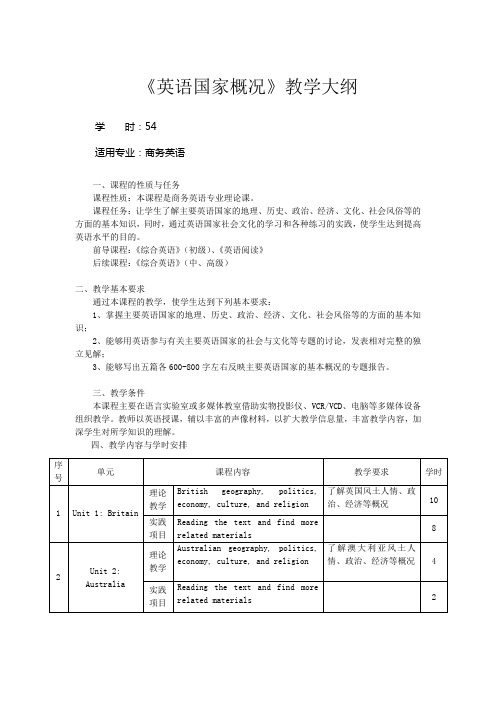
《英语国家概况》教学大纲学时:54适用专业:商务英语一、课程的性质与任务课程性质:本课程是商务英语专业理论课。
课程任务:让学生了解主要英语国家的地理、历史、政治、经济、文化、社会风俗等的方面的基本知识,同时,通过英语国家社会文化的学习和各种练习的实践,使学生达到提高英语水平的目的。
前导课程:《综合英语》(初级)、《英语阅读》后续课程:《综合英语》(中、高级)二、教学基本要求通过本课程的教学,使学生达到下列基本要求:1、掌握主要英语国家的地理、历史、政治、经济、文化、社会风俗等的方面的基本知识;2、能够用英语参与有关主要英语国家的社会与文化等专题的讨论,发表相对完整的独立见解;3、能够写出五篇各600-800字左右反映主要英语国家的基本概况的专题报告。
三、教学条件本课程主要在语言实验室或多媒体教室借助实物投影仪、VCR/VCD、电脑等多媒体设备组织教学。
教师以英语授课,辅以丰富的声像材料,以扩大教学信息量,丰富教学内容,加深学生对所学知识的理解。
四、教学内容与学时安排五、教法说明充分准备,精心设计,灵活运用多种教学方法,充分调动学生的积极性,采取实物投影仪、VCR/VCD、电脑等多媒体设备组织课堂教学。
组织学生讨论,使他们积极参与,以增强其学习兴趣,提高教学效果。
鼓励学生课前预习,使其养成良好的自学习惯。
同时督促其课后写专题报告,以增强学生综合应用英语的能力。
六、考核形式及评分方法实行不同阶段的滚动式测评并进行期末考试。
将平时上课情况及表现与阶段测评、专题报告以及期末考试有机地结合起来,以全方位、客观地对学生的学习情况进行评估。
具体来说,平时上课情况及表现占15%,阶段测评占20%,专题报告占25%,期末考试占40%。
七、教材与参考书1、教材:《英语国家社会与文化入门》朱永涛,高等教育出版社,2000年2、参考资料:《英美概况》温洪瑞、李学珍,山东大学出版社,1997年《澳新风貌》贾海鹰、张前,西北电子科技大学,1999年《当代英语概况》肖惠云,上海外语教育出版社,1996年《文史精华集》李租民、李华田,武汉工业大学出版社,1998年《英语学习背景知识新编》何田,北京大学出版社,1993年3、参考网站://http://www.canadano.1。
- 1、下载文档前请自行甄别文档内容的完整性,平台不提供额外的编辑、内容补充、找答案等附加服务。
- 2、"仅部分预览"的文档,不可在线预览部分如存在完整性等问题,可反馈申请退款(可完整预览的文档不适用该条件!)。
- 3、如文档侵犯您的权益,请联系客服反馈,我们会尽快为您处理(人工客服工作时间:9:00-18:30)。
《英语国家概况》教学大纲An Outline Introduction to Britain and America学时:36学时学分:2分层次:本科二年级适用专业:英语专业第一部分大纲说明一、课程的性质、目的和任务英语国家概况是一门文化知识性课程,主要以英语为媒介系统阐述世界主要英语国家基本概况的学科,是高等学校英语专业本科生的必修课程之一。
教学主要以英语为凭借,全面而系统地向学生介绍世界主要英语国家的基本概况,从而使学生系统地了解这些国家的地理、历史、文化、宗教、社会生活、政治制度、经济状况等方面的情况来培养学生的跨文化交际能力,同时也可以促进加强学生的语言学习,并以批判的眼光分析历史事件。
二、课程的基本要求通过本课程的学习,要求学生对以下几个方面有初步了解:1、地理概况、气候特征、自然灾害2、历史进程、社会变迁、人口发展3、政治制度、经济系统4、文化、教育、宗教、节日三、本课程与相关课程的联系本课程作为英语国家的背景知识课程,对于学生理解英语文化和语言具有重要意义,与英语泛读课程的联系较为紧密。
四、学时分配本课程的教学时间为36学时,安排在第四学期,每周2学时,本课程的教材选用《新编英美概况教程》(第二版),周叔麟、﹝美﹞C.W. Pollard,JuneAlmes主编,北京大学出版社;并辅以英美重要文献资料的阅读和分析。
整个教学顺序安排如下:五、教材与参考书教材:《新编英美概况教程》(第二版),周叔麟,﹝美﹞C.W. Pollard,June Almes主编,北京大学出版社,2010年5月出版。
教学参考书:1.Davidson, James. Nation of Nations. McGraw Hill, 4th edition, 2006. 2. Grafton, John Edited. The Declaration of Independence and Other Great Documents of American History 1775-1865. Dover Publications, Inc. 2000.3. Zinn, Howard. A People's History of the United States: 1492 to Present. Harper Perennial Modern Classics, August 2, 2005.4.来安方编著,张克定校订,《英美概况》(新增订本),郑州:河南人民出版社,2007年8月.5.马丁·吉尔伯特著,王玉菡译,《美国历史地图》,北京:中国青年出版社,2009年.6.马丁·吉尔伯特著,王玉菡译,《英国历史地图》,北京:中国青年出版社,2009年.7.余志远主编《英语国家概况》,北京:外语教育与研究出版社,2000年.课外阅读部分:英国部分:《大宪章》、《权利法案》美国部分:《独立宣言》、《美国宪法》、《人权法案》、《解放黑人奴隶宣言》六、教学方法与手段建议该课程的教学应遵循以下原则:6.1系统性原则:以系统思想为依据,将整个历史部分的教学过程视为一项系统工程,采用系统方法和手段,对教学过程的各个环节以及与教学相关的因素进行系统分析,对教学的内容和程序予以系统设计,以求在现有的条件下达到最佳教学效果。
6.2整体性原则:将教学内容看作有机整体,在教学时间有限的情况下,尽量保证教学内容和教学过程的完整性;将作为教学对象的学生看作整体,不仅丰富其英语国家的背景知识,而且更要拓宽他们的思路和视野,增强他们获取知识,独立思考的能力,提高他们的理性思维水平和整体素质。
6.3层次性原则:根据本课程内容多,覆盖面广的实际情况,将教学内容分为不同层次或等级,分段教学。
6.4目的性原则:教学中不仅重视丰富学生的背景知识,而且更强调引导他们与语言实际相结合,加深、加强对知识的理解与把握。
6.5开放性原则:教学目的、教学内容和教学方法将随着学科的发展情况,随时调整,以适应新形势的需要。
教学中采用教师为主导,学生为主体的教学模式,采用讲座式、讨论式、发现式和研究式的教学方法,充分调动学生的积极性和能动性。
充分利用现代化的教学手段,开发新的教学资源,最大限度地提高教学效率和效果。
七、课程考核方式测试、考查和评估必须有科学性、客观性、全面性和可行性,采用客观测试与主观测试相结合,期末测试与论文写作相结合,书面测试与口头测试相结合。
评估的主要内容有:英美的地理、历史、文化、社会制度等方面。
考核方式:总评成绩=40%平时成绩+60%考试成绩平时成绩:40%1、Attendance:共20分,缺席一次扣5分,迟到早退一次扣2分,直至全部扣完(旷课三次或缺课三分之一不允许参加期末考试)。
2、Homework:共60分,每次课布置作业,分数根据完成情况和质量给出。
3、Presentation:共20分,在课堂上完成,每人做一份报告,分数根据内容的质量和原创性给出。
考试成绩:60%八、说明第一章首先介绍《英语国家概况》课程的性质、内容、要求、考查方式,然后采用讲座的形式重点讲解影响西方文明的哲学家和思想家的生平以及他们的主要思想。
1.1 希腊哲学1.2 中世纪哲学1.3 文艺复兴时期1.4 近现代哲学要求学生知道希腊哲学家苏格拉底、柏拉图、亚里士多德,中世纪哲学家托马斯·阿奎那,文艺复兴时期的培根,近现代哲学家笛卡尔、海德格尔、黑格尔、康德、尼采的生平和主要观点。
第二章英国的地理和气候特征,采用地图结合视频的教学方法讲解。
2.1 英国的名称、岛屿、河流、山脉2.2 各个地区的地理特征2.2.1英格兰2.2.2 苏格兰2.2.3 威尔士2.2.4 北爱尔兰要求学生完全掌握英国每个地区的位置,主要的河流、山峰、国名的拼写和气候特征,正确在地图填出英国四个地区的名字、首府、河道、山峰、海洋。
第三章采用讲座和讨论的形式,分别在五次课里讲解英国主要历史时期的重大历史事件和历史人物。
3.1从公元前不列颠人的巨石阵到征服者威廉成功占领英格兰3.1.2. 不列颠人进入英格兰3.1.3. 罗马人征服英格兰(公元前55年-公元410年)3.1.3.1 几次远征3.1.3.2 罗马文明如何影响不列颠3.1.4 盎格鲁-撒克逊人征服(公元449年-1066年)3.1.5. 诺曼征服(公元1066年)3.1.5.1 英格兰国王王位之争3.1.5.2. 黑斯廷斯战役3.1.5.3 奠定英国封建王朝的基础要求学生了解英国在诺曼征服之前经历的几次外族入侵,以及诺曼征服的经过和重大意义,讨论征服者威廉为什么可以击败其他竞争者。
3.2国家的形成-从诺曼征服到文艺复兴3.2.1 金雀花王朝(公元1154年-1399年)3.2.1.1 约翰国王被迫签署《大宪章》(公元1215年)3.2.1.2 英格兰征服威尔士(公元1277年-1288年)3.2.1.3 英法“百年战争”(公元1337年-1453年)3.2.2 兰卡斯特王朝(公元1399年-1461年)3.2.3 约克王朝(公元1461年-1485年)要求学生掌握几个封建王朝的统治者和各自的施政纲领,比较《大宪章》与《独立宣言》对英美两国的影响,讨论“百年战争”为什么对英法两国来说是件好事,“玫瑰战争”的起因和结果。
3.3都铎王朝3.2.1亨利八世和宗教改革(公元1491年-1547年)3.2.2伊丽莎白一世的统治(公元1558年-1603年)要求学生知道都铎王朝的五位君主的名字,掌握亨利八世推行宗教改革的原因,讨论玛丽一世与伊丽莎白一世两个姐妹之间为什么存在复杂的敌对关系。
3.4 日不落帝国的兴起3.4.1 斯图亚特王朝(公元1603年—1649年,1660年—1714年)3.4.1.1 针对詹姆士一世的火药阴谋(公元1605年)3.4.1.2 英国内战(公元1642年-1651年)3.4.1.3 克伦威尔建立共和政体(公元1649年-1660年)3.4.1.4 查理二世复辟(公元1660年)3.4.1.5 光荣革命(公元1688年)3.4.1.6 英格兰、苏格兰合并(公元1707年)3.4.2 汉诺威王朝(公元1714年—1901年)3.4.2.1 工业革命(公元1760年-1830年)3.4.2.2 维多利亚女王时期(公元1837年-1901年)要求学生掌握英国君主立宪制诞生的过程,讨论工业革命为何首先在英国展开。
3.4两次世界大战中的英国3.4.1 第一次世界大战与英国(公元1914年-1918年)3.4.2 第二次世界大战与英国(公元1939年-1945年)要求学生了解英国在两次世界大战中的角色和作用。
第四章介绍英国的经济体系,要求学生了解英国经济的特征,讨论面临的问题。
第五章介绍英国的社会、文化和教育5.1 英国文化发展的大体趋势5.2 英国国教5.3 英国教育5.4 英国价值观要求学生对英国文化、宗教、教育、价值观有理论的认识。
第六章美国的地理和气候特征,采用地图结合视频的教学方法讲解。
6.1 美国的名称、河流、山脉、气候6.2 乡村、郊区和城市的生活方式6.3 地理分布要求学生完全掌握美国的位置,主要的河流、山峰、国名的拼写和气候特征,正确地在地图填出美国主要城市、首府、河道、山峰、海洋。
讨论美国地形特征对美国国家和人文地理形成的影响。
第七章采用讲座和讨论的形式,分别在五次课里讲解美国主要历史时期的重大历史事件和历史人物。
7.1 从印第安人定居北美洲到殖民时期7.1.1 印第安人文明(公元前1000年)7.1.2 殖民时期(公元1607年-1753年)要求学生了解几个重要的印第安文明,掌握最早的十三个殖民地的名字和性。
7.2美国建国7.2.1 美国独立战争(公元1754年-1783年)7.2.1.1 两次大陆会议7.2.1.2 独立战争的爆发、经过和结果7.2.2 组建新政府(公元1784年-1819年)要求学生掌握独立战争前殖民地与英国政府的各种矛盾和冲突升级的事件,两次大陆会议各自做出怎样重要的决定,讨论《独立宣言》对日后美国政治制度、政府机构、内战、民权运动等的影响。
7.3从西进运动到美国内战7.3.1 美国边疆开拓者和西进运动的意义7.3.2 墨西哥战争(公元1846年-1848年)7.3.3 美国工业革命和社会变革7.3.4 美国内战(公元1861年-1865年)7.3.4.1 南北州分裂7.3.4.2 林肯当选总统7.3.4.3 《解放奴隶宣言》7.3.4.4 战后重建要求学生掌握美国建国后震荡时期的几个重大历史事件,讨论天赋人权和美国梦对西进运动的影响,林肯作为美国人最爱戴的总统之一的原因何在,《解放奴隶宣言》对美国黑人的意义。
